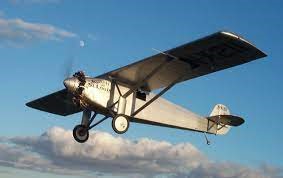
“Once you have tasted flight, you will forever walk the earth with your eyes turned skyward, for there you have been, and there you will always long to return.” ― Leonardo da Vinci
* * *
In yesterday’s TKZ post, James Scott Bell deconstructed the movie The Fugitive and shared some lessons from it. Today, I want to look at a very different movie for a different reason.
The1957 film The Spirit of St. Louis is the story of Charles Lindbergh’s historic flight from New York’s Roosevelt Field to Le Bourget Field in Paris. Lindbergh hoped to win the $25,000 Orteig Prize by being the first to fly non-stop from New York to Paris, but this was no easy task. Six men had already died trying.
Now you would think a movie that follows a thirty-three-hour flight over the ocean would be a huge bore, but the filmmakers came up with a way to present it that engages the audience. Jimmy Stewart in the role of Charles Lindbergh lends authenticity, humor, and occasional hilarity to the film.
Like most stories, this movie is divided into three parts.
Act One covers the night before the flight when Charles Lindbergh is lying awake, dreading the sound of raindrops plunking against the window of his hotel room. This 53-minute act fluctuates between scenes of Lindbergh’s insomnia and flashbacks to his experiences as a U.S. Post Office airmail pilot, and other humorous scenes. From the story-telling point of view, this act provides movie-goers with knowledge of Lindbergh as a man, not a legend. He comes across as a likeable, shy, and determined young pilot.
Act Two recounts the take-off scene in seventeen minutes. I’ll come back to this in detail below.
Act Three is another long segment that follows the flight across the ocean and the landing in Paris, alternating between scenes of the sleep-deprived Lindbergh’s efforts to stay awake, a scary moment when ice forms on the wings and threatens to bring the plane down, and more flashbacks of his life as a barnstorming pilot and as a cadet with the United States Army Air Service.
* * *
But it’s Act Two where the real tension lies. Even though we all know the outcome, I find myself holding my breath whenever I watch the scene.
It begins when Lindbergh arrives at Roosevelt Field on the morning of May 20, 1927. The conditions are awful. The rain has made the field a muddy mess, and the fog renders a successful takeoff over the very tall trees at the end of the runway unlikely. Frank Mahoney, the owner of the Ryan Aircraft Company which built the plane, advises Lindbergh to wait and try again later. But the young pilot thinks there may be a chance, and he places a white marker at a certain point on the side of the sloppy runway. If he tries the takeoff and reaches the marker before the plane gets off the ground, he says he’ll abort the effort.
Only Lindbergh can make the Go/No-Go call, and he knows the odds are not good. He suits up, climbs into the cockpit, and does the runup. You can see the doubt on his face when he raises his hand in a goodbye gesture to the small group of people who came to see him off.
No one would blame him if he decided to wait. But you can almost hear his inner voice say, “This is your moment. Don’t let it pass you by.”
At approximately the exact middle of the movie (and I know James Scott Bell will love this), Lindbergh finalizes his decision by calling out the words that will start the plane forward: “Pull the chocks.” There will be no turning back.
A group of men actually push the plane to get it moving in the muck, and the little aircraft, heavy with fuel and struggling against the poor-to-horrible weather conditions, slogs its way down the field toward a line of trees that look increasingly ominous.
It would be hard to describe the scene of the actual takeoff, so I’ll let you watch this three-minute clip instead:
* * *
Charles Lindbergh was passionate about his chosen profession, and he put in the time to learn his craft. He had honed his experience through years of barnstorming, flying airmail routes, and giving lessons. He went through training with the United States Army Air Service at Brooks Field in Texas and earned his Army pilot’s wings and a commission as a second lieutenant in the Air Service Reserve Corps.
But even though he was the sole pilot of The Spirit of St. Louis when he flew across the ocean, Lindbergh’s effort would have been impossible without the support and knowledge of many others.
A group of St. Louis businessmen had financed the building of the aircraft. The owners and employees of the Ryan Aircraft Company supplied the experience and commitment to design the plane that could make a journey of almost four thousand miles. Lindbergh couldn’t have lifted off the ground without their help.
* * *
It seems I find an analogy to writing in just about everything these days, and it’s easy to see the connection between lifting off on a flight where the conditions aren’t perfect and launching a novel.
As everyone here knows, the preparation for bringing a novel to publication is long and difficult. And it isn’t just the hard work of meeting the weekly quota. The background of life experiences, craft books, writing courses, and blogs like The Kill Zone, all combine to prepare the writer for his/her effort.
In most books, only the author’s name is on the cover. But the product is usually the result of many people who willingly came alongside to make the book a success. Friends, editors, mentors, beta readers, endorsers, experts, and supporters from other areas pour their knowledge and expertise into the project.
But at some point, the author has to make the last preparations and commit to the flight. A new book launch may not be as risky as taking off in an airplane to fly a course no one has flown before, but to the author, it is just as exciting.
* * *
So there you have it. Today is launch day for Lacey’s Star: A Lady Pilot-in-Command Novel. It’s been a long, bumpy runway. Now we’ll see how she flies.
* * *
So TKZers: Have you launched a book recently? Tell us about it. What advice do you have for authors about making a book launch successful?
* * *

PULL THE CHOCKS!
Private pilot Cassie Deakiin is smart, funny, and determined. She can land a plane safely in an emergency, but can she keep her cool when confronted by a murderer?
Lacey’s Star: A Lady Pilot-in-Command Novel began flying off the shelves today. $1.99 at Amazon Barnes & Noble Apple Books Kobo Google Play
Have a nice flight, Cassie.
